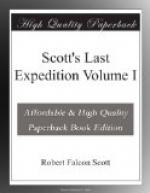This attitude was now manifested in the many yards of cinematograph film remaining on hand and yet greater number recorded as having been sent back in the ship, in the boxes of negatives lying on the shelves and a well-filled album of prints.
Of the many admirable points in this work perhaps the most notable are Ponting’s eye for a picture and the mastery he has acquired of ice subjects; the composition of most of his pictures is extraordinarily good, he seems to know by instinct the exact value of foreground and middle distance and of the introduction of ‘life,’ whilst with more technical skill in the manipulation of screens and exposures he emphasises the subtle shadows of the snow and reproduces its wondrously transparent texture. He is an artist in love with his work, and it was good to hear his enthusiasm for results of the past and plans of the future.
Long before I could gaze my fill at the contents of the dark room I was led to the biologists’ cubicle; Nelson and Day had from the first decided to camp together, each having a habit of methodical neatness; both were greatly relieved when the arrangement was approved, and they were freed from the chance of an untidy companion. No attempt had been made to furnish this cubicle before our departure on the autumn journey, but now on my return I found it an example of the best utilisation of space. The prevailing note was neatness; the biologist’s microscope stood on a neat bench surrounded by enamel dishes, vessels, and books neatly arranged; behind him, when seated, rose two neat bunks with neat, closely curtained drawers for clothing and neat reflecting sconces for candles; overhead was a neat arrangement for drying socks with several nets, neatly bestowed. The carpentering to produce this effect had been of quite a high order, and was in very marked contrast with that exhibited for the hasty erections in other cubicles. The pillars and boarding of the bunks had carefully finished edges and were stained to mahogany brown. Nelson’s bench is situated very conveniently under the largest of the hut windows, and had also an acetylene lamp, so that both in summer and winter he has all conveniences for his indoor work.




